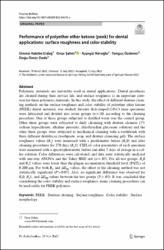| dc.contributor.author | Erdağ, Ümmü Habibe | |
| dc.contributor.author | Şahin, Onur | |
| dc.contributor.author | Köroğlu, Ayşegül | |
| dc.contributor.author | Özdemir, Tonguç | |
| dc.contributor.author | Dede, Doğu Ömür | |
| dc.date.accessioned | 2022-09-12T10:39:48Z | |
| dc.date.available | 2022-09-12T10:39:48Z | |
| dc.date.issued | 2022 | en_US |
| dc.identifier.uri | https://hdl.handle.net/20.500.12868/1601 | |
| dc.description.abstract | Polymeric materials are inevitably used in dental applications. Dental prostheses
are cleaned during their service life, and surface roughness is an important criterion for these polymeric materials. In this study, the efect of diferent denture cleaning methods on the surface roughness and color stability of polyether ether ketone
(PEEK) dental materials was studied. Seventy disk-shaped (10×3 mm) specimens
were fabricated and divided into seven groups (n=10) according to the cleaning
procedure. One of these groups subjected to distilled water was the control group.
Other three groups were subjected to daily cleansing with denture cleaners (5%
sodium hypochlorite, alkaline peroxide, chlorhexidine gluconate solution) and the
other three groups were subjected to mechanical cleaning with a toothbrush with
three diferent dentifrices (toothpaste, soap, and denture cleansing gel). The surface
roughness values (Ra) were measured with a proflometer before (Ra0) and after
cleaning procedures for 270 days (Ra1). CIELab color parameters of each specimen
were measured with a spectrophotometer before and after 7 days of storage in a coffee solution. Color diferences were calculated, and data were statistically analyzed
with one-way ANOVA and the Tukey HSD test (α=.05). For all test groups, Ra0
and Ra1 values were lower than the plaque accumulation threshold level (PATL) of
0.200 μm. For both Ra and ΔE00 values, the efect of the cleaning method was not
statistically signifcant (P>0.05). Also, no signifcant diference was observed for
Ra0, Ra1, and ΔE00 values between the test groups (P>.05). It was concluded that
considering the color stability and surface roughness, many cleaning procedures can
be used safely for PEEK polymers. | en_US |
| dc.language.iso | eng | en_US |
| dc.relation.isversionof | 10.1007/s00289-022-04393-x | en_US |
| dc.rights | info:eu-repo/semantics/closedAccess | en_US |
| dc.subject | PEEK | en_US |
| dc.subject | Denture cleaning | en_US |
| dc.subject | Surface roughness | en_US |
| dc.subject | Color stability | en_US |
| dc.subject | Surface morphology | en_US |
| dc.title | Performance of polyether ether ketone (peek) for dental applications: surface roughness and color stability | en_US |
| dc.type | article | en_US |
| dc.contributor.department | ALKÜ, Fakülteler, Diş Hekimliği Fakültesi, Ortodonti Ana Bilim Dalı | en_US |
| dc.identifier.startpage | 1 | en_US |
| dc.identifier.endpage | 15 | en_US |
| dc.relation.journal | Polymer Bulletin | en_US |
| dc.relation.publicationcategory | Makale - Uluslararası Hakemli Dergi - Kurum Öğretim Elemanı | en_US |


















